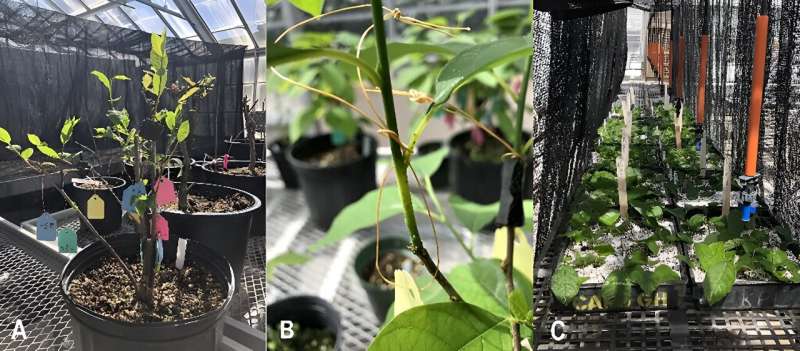This article has been reviewed according to Science X's editorial process and policies. Editors have highlighted the following attributes while ensuring the content's credibility:
fact-checked
peer-reviewed publication
trusted source
proofread
Investigating the efficacy of methods to stimulate adventitious rooting of Lindera benzoin stem cuttings

The variability among woody plants in their responses to asexual propagation techniques poses challenges and severe limits for commercial production. While some species readily root from stem cuttings, others are more difficult to propagate despite their desirable traits
A new study investigated the efficacy of various methods to stimulate rooting on stem cuttings of northern spicebush (Lindera benzoin), a difficult-to-root woody plant.
Studies have proven evidence that etiolation (growing plants without light or under heavy shade) and the application of growth regulators stimulate root formation. Etiolation, especially when combined with synthetic auxins like IBA or NAA, has shown positive effects on rooting in various plant species.
Banding, a method of localized etiolation where an opaque band is used to exclude light from the base of the cutting, has also been effective, especially when combined with the Ian BA application. Research on northern spicebush (Lindera benzoin) suggests that these techniques can improve rooting success, thus facilitating commercial production. Optimal results are often achieved with a combination of full etiolation and banding.
The objective of this research was to determine the most successful combination of lighting and banding treatments for increased rooting of L. benzoin stem cuttings, making rapid commercial production of this species more feasible.
The study demonstrates that rooting percentage and root quantity in Lindera benzoin can be notably enhanced through etiolation, shading, and banding methods. Etiolation alone or combined with banding (without IBA) shows the most promising results with minimal effort. However, banding and IBA treatments also significantly boost rooting in both shaded and light-grown cuttings. This allows commercial growers to choose the most suitable propagation method based on their resources and constraints.
An improved understanding of asexual propagation techniques will allow the horticulture industry to make more clonal selections for desirable ornamental traits and bring L. benzoin and other underused woody plants to a wider market. The propagation methods implemented in this experiment have been widely used across numerous genera and species, and further investigations should be undertaken to study their effectiveness in new taxa.
The work is published in the journal HortScience.
More information: Caroline Stokes et al, Light Reduction, Banding, and IBA Treatments Influence Adventitious Rooting of Lindera benzoin Stem Cuttings, HortScience (2023). DOI: 10.21273/HORTSCI17022-22
Journal information: HortScience
Provided by American Society for Horticultural Science





















